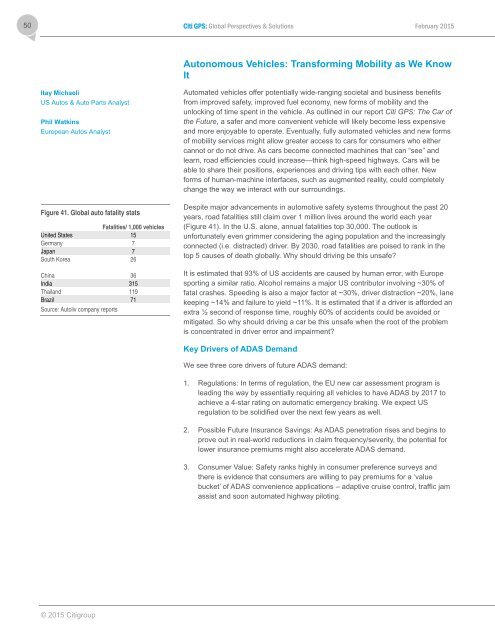TECHNOLOGY AT WORK
1Oclobi
1Oclobi
Create successful ePaper yourself
Turn your PDF publications into a flip-book with our unique Google optimized e-Paper software.
50<br />
Citi GPS: Global Perspectives & Solutions February 2015<br />
Autonomous Vehicles: Transforming Mobility as We Know<br />
It<br />
Itay Michaeli<br />
US Autos & Auto Parts Analyst<br />
Phil Watkins<br />
European Autos Analyst<br />
Figure 41. Global auto fatality stats<br />
Fatalities/ 1,000 vehicles<br />
United States 15<br />
Germany 7<br />
Japan 7<br />
South Korea 26<br />
China 36<br />
India 315<br />
Thailand 119<br />
Brazil 71<br />
Source: Autoliv company reports<br />
Automated vehicles offer potentially wide-ranging societal and business benefits<br />
from improved safety, improved fuel economy, new forms of mobility and the<br />
unlocking of time spent in the vehicle. As outlined in our report Citi GPS: The Car of<br />
the Future, a safer and more convenient vehicle will likely become less expensive<br />
and more enjoyable to operate. Eventually, fully automated vehicles and new forms<br />
of mobility services might allow greater access to cars for consumers who either<br />
cannot or do not drive. As cars become connected machines that can “see” and<br />
learn, road efficiencies could increase—think high-speed highways. Cars will be<br />
able to share their positions, experiences and driving tips with each other. New<br />
forms of human-machine interfaces, such as augmented reality, could completely<br />
change the way we interact with our surroundings.<br />
Despite major advancements in automotive safety systems throughout the past 20<br />
years, road fatalities still claim over 1 million lives around the world each year<br />
(Figure 41). In the U.S. alone, annual fatalities top 30,000. The outlook is<br />
unfortunately even grimmer considering the aging population and the increasingly<br />
connected (i.e. distracted) driver. By 2030, road fatalities are poised to rank in the<br />
top 5 causes of death globally. Why should driving be this unsafe?<br />
It is estimated that 93% of US accidents are caused by human error, with Europe<br />
sporting a similar ratio. Alcohol remains a major US contributor involving ~30% of<br />
fatal crashes. Speeding is also a major factor at ~30%, driver distraction ~20%, lane<br />
keeping ~14% and failure to yield ~11%. It is estimated that if a driver is afforded an<br />
extra ½ second of response time, roughly 60% of accidents could be avoided or<br />
mitigated. So why should driving a car be this unsafe when the root of the problem<br />
is concentrated in driver error and impairment?<br />
Key Drivers of ADAS Demand<br />
We see three core drivers of future ADAS demand:<br />
1. Regulations: In terms of regulation, the EU new car assessment program is<br />
leading the way by essentially requiring all vehicles to have ADAS by 2017 to<br />
achieve a 4-star rating on automatic emergency braking. We expect US<br />
regulation to be solidified over the next few years as well.<br />
2. Possible Future Insurance Savings: As ADAS penetration rises and begins to<br />
prove out in real-world reductions in claim frequency/severity, the potential for<br />
lower insurance premiums might also accelerate ADAS demand.<br />
3. Consumer Value: Safety ranks highly in consumer preference surveys and<br />
there is evidence that consumers are willing to pay premiums for a ‘value<br />
bucket’ of ADAS convenience applications – adaptive cruise control, traffic jam<br />
assist and soon automated highway piloting.<br />
© 2015 Citigroup










